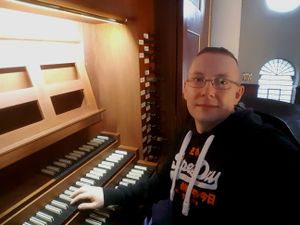Using the Sonus Paradisi produced Hauptwerk sample set of the 1683 Arp Schnitger Organ at St. Jacobi, Lüdingworth, Germany, I recorded the musical setting of the Lord's Prayer "Vater unser im Himmelreich" from the Gdansk Tablature from 1591. It is the 20th piece in the collection.
While the composer of the music is unknown, musicologists suggest the most likely composer of these pieces would Cajus Schmiedtlein (c1555 - 1611), who was the appointed organist at the Marienkirche in Danzig (today's Gdansk) from 1585 until 1611.
Using just the Rohrfloit 8' and Hohlfloit 4’ of the Hauptwerk (or the Great division) allows me to present this piece with two organ stops still dating back to 1599, which is the same era in which the music was composed.
Some background information on the Gdansk Tablature:
A manuscript with the signature “Ms. 300 R/Vv. 123” at the Gdansk State Archive in Gdansk (German: Danzig), Poland contains a varying collection of documents dating to a time period between 1571 and 1627 : the rights and duties of burghers, a list of city council members from 1343 to 1619, a city council balance sheet including musicians’ pay from 1604 to 1605, a list of royal officials from 1457 to 1619, privileges granted to the Hanseatic cantorate in Lund, notes (excerpts from various city documents) by the city council secretary Martinus Lange, and forty-two keyboard pieces, two notated in New German Tablature and forty in Italian Intavolatura on two staves.
The musical compositions can be roughly divided into three categories: seventeen Phantasias, twenty-four keyboard arrangements of different types of vocal music, and one chorale prelude.
At the bottom of some of the pages are inscribed epigrams in Latin, Greek or German which perhaps point to the author’s mindset at the time of writing. The manuscript cover carries the initials “PWSP”, possibly the writer’s or owner’s initials, and the number 1591, which by now is commonly accepted as the year in which these stacks of loose papers were bound together.
This collection of music is frequently referred to as the Gdansk Tablature (Polish: Tabulatura Gdanska; German: Danziger Tabulatur).
Piece no. 20 in the collection is a chorale prelude on the on Martin Luther's musical paraphrase of the Lord's Prayer: Vater unser im Himmelreich. The composition is titled in its lower German dialect spelling as "Vader unse ym Hemmelrick" and is spread over two pages, each page containing an epigram at its bottom.
The epigram on the first page says:
Mors tua, mors CHRISTI, fraus mundi, Gloria coeli. Et dolor inferni, sunt meditanda tibi.
Which translates roughly into:
Thy death, the death of Christ, the world’s vexation, heaven’s glory, Hell’s horror, make thy meditation.
The epigram on the second page says:
Principium vitae dolor est, dolor exitus ingens Et medium labor est, vivere quis cupiat.
Translating into:
In the beginning of life there is pain, and there is great pain at its ending. And in-between there is work; Who would want to live?
